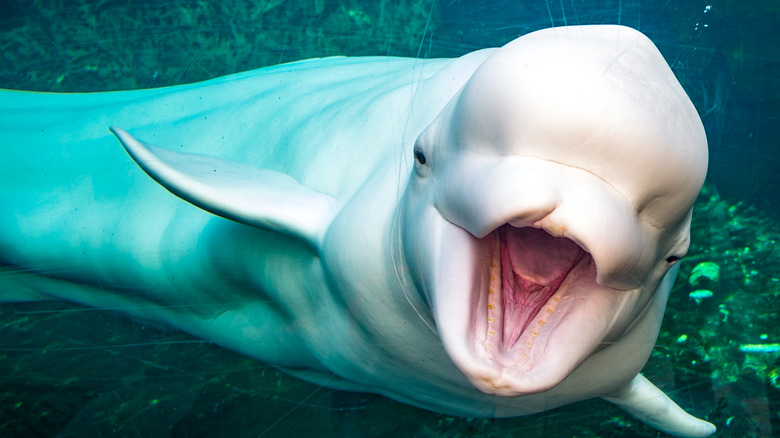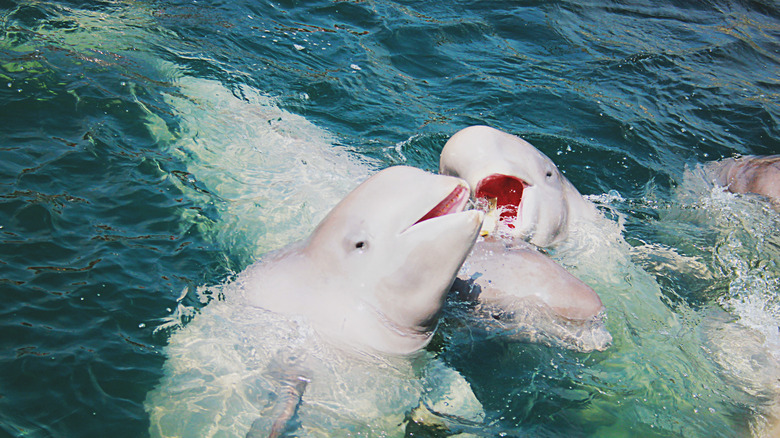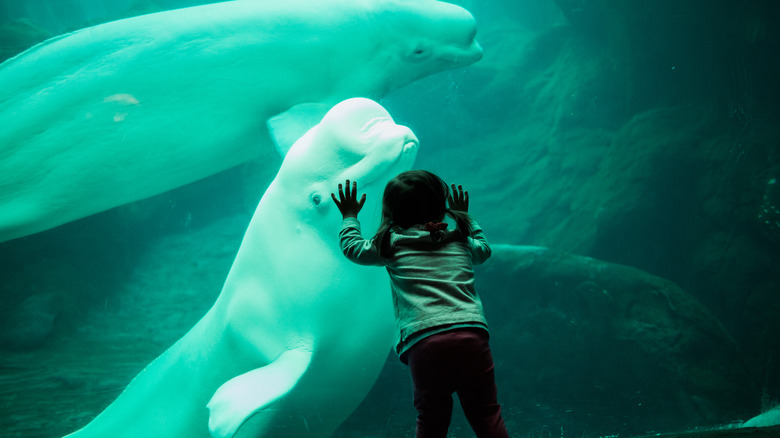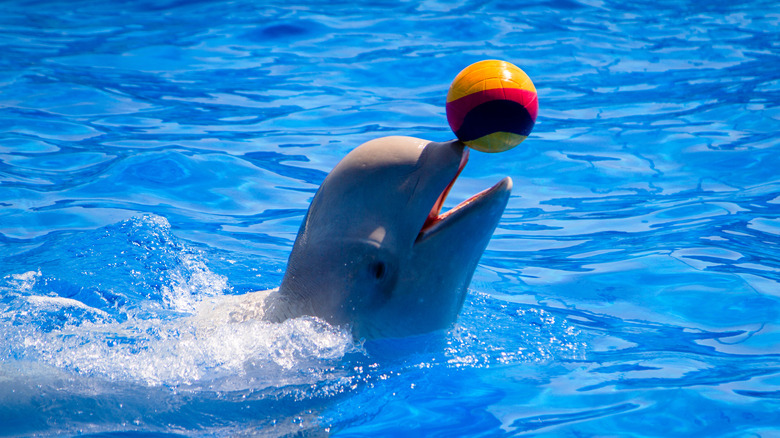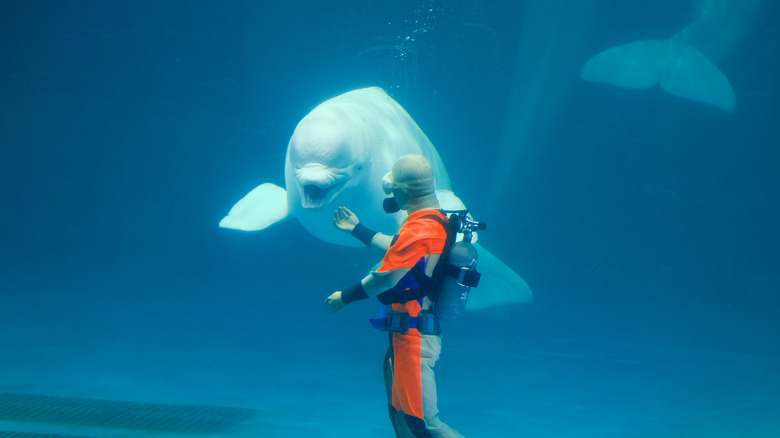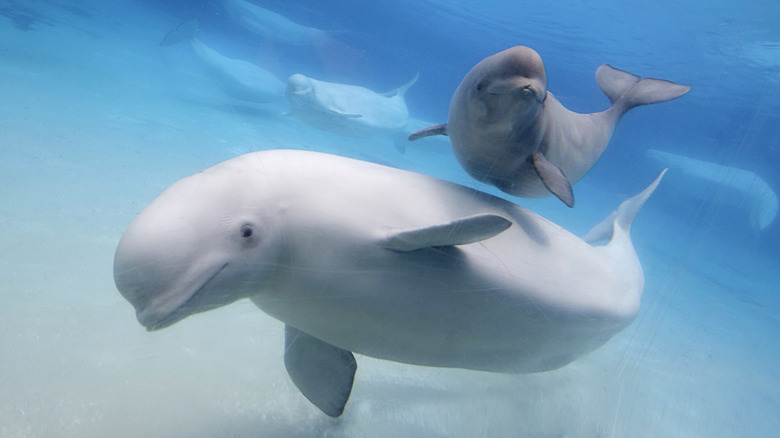The Reason Scientists Say Beluga Whales Can Communicate With Humans
In the depths of the world's oceans, different species of whale families communicate through various forms of song. Sperm whales, thought to separate into different "clans," communicate using a series of different clicks, per BBC News. But according to a study in Nature Communications, sperm whales in various clans — which can include more than 1,000 whales — communicate using different clicking languages, unknown to foreign whale clans. These regional accents are like "football supporters wearing their team's colors," the lead researcher told BBC News, indicating kinship between clans.
Whale songs of this kind are so mesmerizing that they were used to spark an environmental movement in the 1970s to save a dwindling whale population, according to NPR. Whale "singing" evoked so much empathy and understanding about a previously mysterious animal that it helped the world pay attention to them and enact bans on hunting. As the most vocal of all whale species, the beluga whale naturally also has its own unique form of speech that it can use to communicate with others — and even across species (via History Daily).
'Canaries of the sea'
According to History Daily, beluga whales are more communicative than humpback whales, sperm whales, or any other type of whale. However, while humpback whales and other mammals use vocal cords to form "speech," beluga whales lack this body part. Instead, they push air "through the nasal sacs near their blowholes" to produce a series of "clicks, whistles, trills, and other noises," per History Daily. Through these noises, beluga whales are able to communicate, find food, and warn each other of predators using echolocation.
The varying and numerous ways in which beluga whales communicate have won them the nickname of the "canaries of the sea," according to National Geographic. Native to the Arctic, where long stretches of darkness occur, beluga whales heavily rely on sound rather than sight to navigate. However, ships and other human developments have blocked their ability to use echolocation communication, muting beluga whale calls and causing calves to lose track of their clan.
Cross-species communication
Some whale species like orcas use their songs to communicate with a tight inner circle, according to The Science Times. However, beluga whale clans are enormous in comparison, perhaps because they are able to communicate across very far distances using echolocation. According to a study in Scientific Reports, beluga whales don't discriminate based on sex, age, or habitat when forming a clan, which can grow to thousands of whales across the far reaches of the ocean.
In fact, beluga whales have even learned the language of dolphins after being held in captivity with them, according to Newsweek. In the wild, they have also been documented to mimic the calls of sea birds. In 2019, one such beluga whale caught playing with a seagull was thought to have escaped from a Russian training facility and was found in the waters off the coast of Norway with a camera attached to a harness on its back (via 9News). Commonly found in ocean waters near Russia — as well as Alaska, Greenland, and Canada — "beluga" actually means "white" in Russian, per History Daily.
Noc the beluga
The U.S. has also been training marine mammals like beluga whales and dolphins to detect Arctic mines and torpedoes since the 1960s during the Cold War, according to Smithsonian Magazine. Through the Navy Marine Mammal Program, the U.S. deployed one team of belugas called the "Cold Ops" that included one young calf raised in captivity named Noc. What scientists found was that being around humans so much eventually led Noc to remarkably mimic human speech as well.
The research team often used the word "out" to call divers to the surface. One day, they heard the word transmitted through an underground radio they used to communicate, but they realized that no human was online. After realizing it was Noc mimicking the word "out," they started to record his speech patterns. After analyzing the recordings, they found that Noc's speech mimicked the rhythm, amplitude, frequencies, and intervals between words of English speakers (via Current Biology). It's unclear what exactly Noc was trying to communicate. Some believed the young whale's vocalizations were a means of play or boredom, while others thought it was a cry for help to be released from captivity.
A helping hand
In 2009, another beluga whale named Mila showed that this animal can communicate across species. While competing in a free dive competition in northeast China — in which no oxygen tanks were permitted — a young diver's legs became paralyzed while she was underwater (via National Geographic). Because the competition was a contest in which the winner could become a whale trainer, the diver was swimming in a tank with beluga whales. Luckily for her, Mila the beluga noticed what was happening as the diver began to sink to the bottom of the 20-foot-deep icy tank, per National Geographic. In close contact with her trainers, who often dived with her, Mila could tell something was up.
Mila approached the diver, gripped her leg in her mouth gently, and pulled her to the surface to safety. An organizer of the event told National Geographic Mila was "a sensitive animal who works closely with humans" and that the diver "owes her life" to Mila.
The Grandmother's Club
This isn't the only example of belugas acting with gentleness and care. According to History Daily, beluga whales were added to the list of animals that share knowledge across generations of older female members known as the "Grandmother's Club" in 2018. Sharing a spot on this list with elephants, killer whales, and certain species of primates, beluga whales are among many species of whales that travel in pods led by grandmothers thought to help descendants survive by sharing secrets on where to find food and avoid predators (via Live Science). Female beluga whales and their close cousin, the narwhal, even go through menopause like humans, according to CBC News.
However, beluga whale societies may be even more complex than other species in the Grandmother's Club, as they have been shown to also build their social networks on the patriarchal side of the family, as well as by following cousins and "friends" without any genetic relationship, according to a study in Scientific Reports. As belugas have learned to communicate like humans, perhaps we, too, have something to learn from these altruistic underwater beluga societies.
